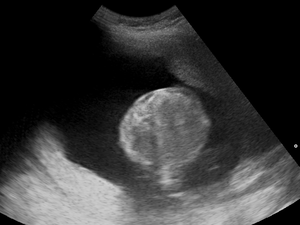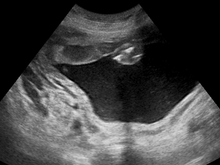Polyhydramnios
Polyhydramnios is a medical condition describing an excess of amniotic fluid in the amniotic sac. It is seen in about 1% of pregnancies.[1][2][3] It is typically diagnosed when the amniotic fluid index (AFI) is greater than 24 cm.[4][5] There are two clinical varieties of polyhydramnios: chronic polyhydramnios where excess amniotic fluid accumulates gradually, and acute polyhydramnios where excess amniotic fluid collects rapidly.
| Polyhydramnios | |
|---|---|
| Other names | Polyhydramnion, hydramnios, polyhydramnios |
 | |
| Specialty | Obstetrics |
The opposite to polyhydramnios is oligohydramnios, not enough amniotic fluid.
Presentation
Associated conditions
Fetuses with polyhydramnios are at risk for a number of other problems including cord prolapse, placental abruption, premature birth and perinatal death. At delivery the baby should be checked for congenital abnormalities.
Causes

In most cases, the exact cause cannot be identified. A single case may have one or more causes, including intrauterine infection (TORCH), rh-isoimmunisation, or chorioangioma of the placenta. In a multiple gestation pregnancy, the cause of polyhydramnios usually is twin-to-twin transfusion syndrome. Maternal causes include cardiac problems, kidney problems, and maternal diabetes mellitus, which causes fetal hyperglycemia and resulting polyuria (fetal urine is a major source of amniotic fluid).
A recent study distinguishes between mild and severe polyhydramnios and showed that Apgar score of less than 7, perinatal death and structural malformations only occurred in women with severe polyhydramnios.[6] In another study, all patients with polyhydramnios, that had a sonographically normal fetus, showed no chromosomal anomalies.[4]
(M/C for polyhydramnio is fetal anomalies 'Williams Obstetrics, 24th Edition – Cunningham, Leveno, Bloom et al. Table 11-2) but these anomalies include:
- gastrointestinal abnormalities such as esophageal atresia and duodenal atresia (causing inability to swallow amniotic fluid), anencephaly, facial cleft, neck masses, tracheoesophageal fistula, and diaphragmatic hernias. An annular pancreas causing obstruction may also be the cause.
- Bochdalek's hernia, in which the pleuro-peritoneal membranes (especially the left) will fail to develop and seal the pericardio-peritoneal canals. This results in the stomach protrusion up into the thoracic cavity, and the fetus is unable to swallow sufficient amounts of amniotic fluid.
- fetal renal disorders that result in increased urine production during pregnancy, such as in antenatal Bartter syndrome.[7] Molecular diagnosis is available for these conditions.[8]
- neurological abnormalities such as anencephaly, which impair the swallowing reflex. Anencephaly is failure of close of the rostral neuropore (rostral neural tube defect). If the rostral neuropore fails to close there will be no neural mechanism for swallowing.
- chromosomal abnormalities such as Down syndrome and Edwards syndrome, which is itself often associated with gastrointestinal abnormalities.
- Skeletal dysplasia, or dwarfism. There is a possibility of the chest cavity not being large enough to house all of the baby's organs causing the trachea and esophagus to be restricted, not allowing the baby to swallow the appropriate amount of amniotic fluid.
- sacrococcygeal teratoma
Diagnosis
There are several pathologic conditions that can predispose a pregnancy to polyhydramnios. These include a maternal history of diabetes mellitus, Rh incompatibility between the fetus and mother, intrauterine infection, and multiple pregnancies.
During the pregnancy, certain clinical signs may suggest polyhydramnios. In the mother, the physician may observe increased abdominal size out of proportion for her weight gain and gestation age, uterine size that outpaces gestational age, shiny skin with stria (seen mostly in severe polyhydramnios), dyspnea, and chest heaviness. When examining the fetus, faint fetal heart sounds are also an important clinical sign of this condition.
Treatment
Mild asymptomatic polyhydramnios is managed expectantly. A woman with symptomatic polyhydramnios may need hospital admission. Antacids may be prescribed to relieve heartburn and nausea. No data support dietary restriction of salt and fluid. In some cases, amnioreduction, also known as therapeutic amniocentesis, has been used in response to polyhydramnios.[9]
See also
References
- Alexander ES, Spitz HB, Clark RA (1982). "Sonography of polyhydramnios". AJR Am J Roentgenol. 138: 343. doi:10.2214/ajr.138.2.343.CS1 maint: multiple names: authors list (link)
- Hill LM, Breckle R, Thomas ML, Fries JK (January 1987). "Polyhydramnios: ultrasonically detected prevalence and neonatal outcome". Obstet Gynecol. 69: 21–5. PMID 3540761.CS1 maint: multiple names: authors list (link)
- Hobbins JC, Grannum PA, Berkowitz RL, Silverman R, Mahoney MJ (June 1979). "Ultrasound in the diagnosis of congenital anomalies". Am. J. Obstet. Gynecol. 134: 331–45. PMID 453266.CS1 maint: multiple names: authors list (link)
- Barnhard Y, Bar-Hava I, Divon MY (Nov 1995). "Is polyhydramnios in an ultrasonographically normal fetus an indication for genetic evaluation?". Obstet Gynecol. 173 (5): 1523–7. doi:10.1016/0002-9378(95)90643-6.CS1 maint: multiple names: authors list (link)
- Brady K, Polzin WJ, Kopelman JN, Read JA (1992). "Risk of chromosomal abnormalities in patients with idiopathic polyhydramnios". Obstet Gynecol. 79: 234–8.CS1 maint: multiple names: authors list (link)
- Bundgaard A, Andersen BR, Rode L, Lebech M, Tabor A, Prevalence of polyhydramnios at a Danish hospital—a population-based study. Acta Obstet Gynecol Scand. 2007; 86(12): 1427–31.
- Seyberth HW. (2008). "An improved terminology and classification of Bartter-like syndromes". Nat Clin Pract Nephrol. 4 (10): 560–7. doi:10.1038/ncpneph0912. PMID 18695706.
- "Hereditary disease: Bartter syndrome". Moldiag.de. Retrieved 2012-09-28.
- Piantelli G, Bedocchi L, Cavicchioni O, et al. (2004). "Amnioreduction for treatment of severe polyhydramnios". Acta bio-medica : Atenei Parmensis. 75. Suppl 1: 56–8. PMID 15301292.
External links
| Classification | |
|---|---|
| External resources |